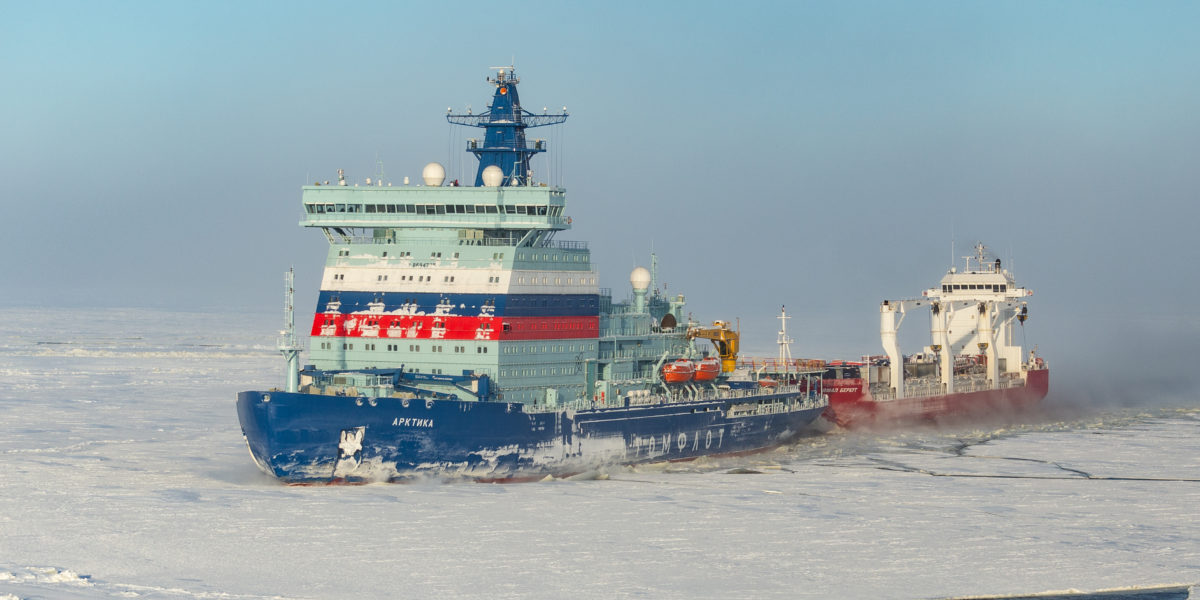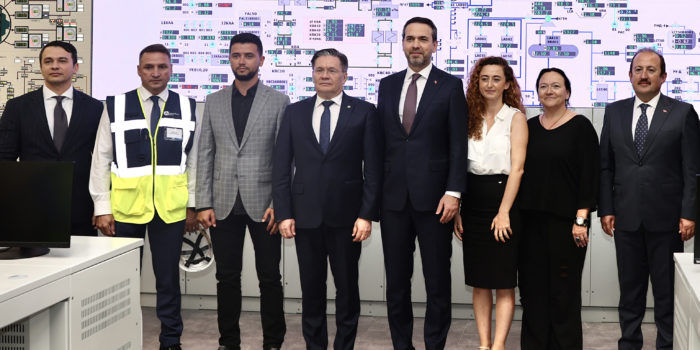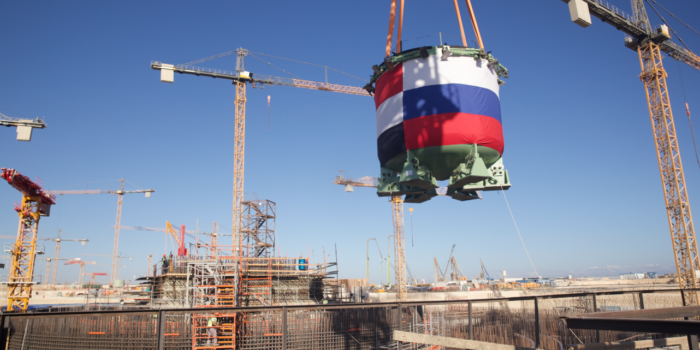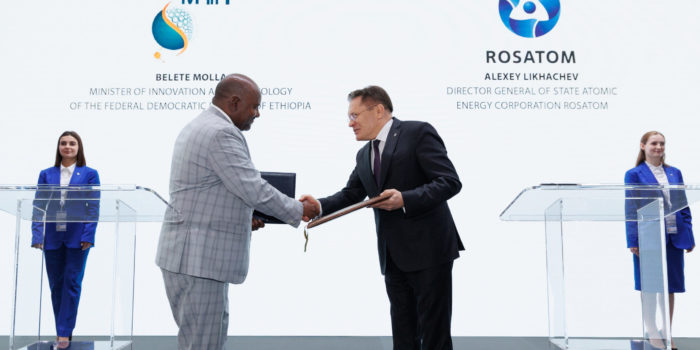The Northern Sea Route (NSR) is the shortest shipping route between the western part of Eurasia and the Asia-Pacific region. Administratively, the Northern Sea Route begins at the boundary between the Barents and Kara Seas (the Kara Strait) and ends in the Bering Strait (Cape Dezhnev). The route is 5600-km long. The NSR straddles the seas of the Arctic Ocean (Kara, Laptev, East Siberian, and Chukchi Seas).
The NSR serves the ports located in the Artic and on large Siberian rivers. There are currently 6 major seaports located on the NSR route in the Arctic Zone of the Russian Federation: Sabetta, Dikson, Dudinka, Khatanga, Tiksi, and Pevek ports.
The seas of the Arctic Ocean are covered with ice for most of the year. Icebreaker escorting is organized to ensure safe navigation along the NSR. Russia is the only country in the world with a nuclear icebreaker fleet. The operator of the fleet is FSUE Atomflot – an entity of Rosatom.
In 2018, Rosatom was designated the infrastructure operator of the NSR.
The NSR development plan up until 2035, in terms of Rosatom’s responsibility, provides for the creation of the necessary infrastructure: from the construction of icebreaking and hydrographic vessels to the creation of ports and digital services to improve navigation efficiency.
In order to ensure sustainable and environmentally responsible navigation on the NSR, starting from 2021, on the initiative of Rosatom, the Marine Research Center of the Lomonosov Moscow State University, (MSU MRC) launched a pilot research program on environmental monitoring of the NSR, taking into account the advanced Russian and international requirements and practices in the field of environmental research and protection, and the development of a program for regular monitoring of the NSR water area. In 2023, a detailed multi-level system of environmental monitoring measures was developed and presented. The created program was supported by an International Group of Experts (IGE), which monitored the progress of the project. This program will be used to solve environmental problems in the development of the NSR as a single infrastructure project.
Cargo traffic along the Northern Sea Route (NSR) in 2022 exceeded the target of the federal project “Development of the Northern Sea Route” curated by Rosatom by more than 2 million tons. The volume of cargo transported along the NSR in 2022 amounted to 34.117 million tons.
Cargo traffic on the NSR is growing rapidly: 2012 – 3.87 million tons, 2013 – 3.93 million tons, 2014 – 3.982 million tons, 2015 – 5.392 million tons, 2016 – 7.265 million tons, 2017 – 10.7 million tons, 2018 – 19.7 million tons, 2019 – 31.5 million tons, 2020 – 32.978 million tons, 2021 – 34.867 million tons, 2022 – 34.117 million tons.
Decree of the Government of the Russian Federation No. 2115-r of August 1, 2022 approved a new Plan for the Development of the Northern Sea Route for the period up to 2035 (hereinafter referred to as the Plan). Rosatom is a party in charge for the majority of the activities under the Plan which are structured in the following areas: development of the freight base, transport infrastructure, cargo and icebreaker fleet, safety of navigation on the NSR, navigation management and development on the NSR.
The first target for the development of the Northern Sea Route is to bring the cargo flow through the NSR to 80 million tons by 2024. A powerful Arctic nuclear icebreaker fleet is needed to attain this figure.
Rosatom is pursuing this objective in two areas: extending the life of existing icebreakers and upgrading the icebreaker fleet.
To date, there are seven nuclear icebreakers in the icebreaking fleet of FSUE Atomflot: 50 let Pobedy, Vaigach, Yamal, Taimyr, Arktika serial universal nuclear icebreaker (SUNI) (project 22220), Sibir SUNI (project 22220), Ural SUNI (project 22220), as well as nuclear container ship Sevmorput. The operational period of the icebreakers Yamal, Vaigach, and Taimyr has been extended to 36 years and will end in 2027-2028. This will make it possible to carry out the necessary scope of work on the NSR before the commissioning of new nuclear-powered vessels. The Sevmorput nuclear container ship is planned to be operated until 2024-2025, with the subsequent extension of the life of the nuclear power plant until 2032.
Under construction are:
- Yakutia SUNI (project 22220) with a capacity of 60 MW, scheduled to be commissioned in 2024, ice class – Icebreaker 9, construction at the shipyard – Baltic Shipyard JSC – launched in 2022;
- Chukotka SUNI (project 22220) with a capacity of 60 MW, scheduled to be commissioned in 2026, ice class – Icebreaker 9, construction at the shipyard – Baltic Shipyard JSC;
- Lead icebreaker Rossiya (project 10510 Leader) with a capacity of 120 MW, scheduled to be commissioned in 2027, ice class – Icebreaker 9, construction at the shipyard of Zvezda SSK LLC.
In February 2023, a contract was signed for the construction of the 5th and 6th SUNIs of project 22220 with the participation of federal budget funds, the commissioning of which is planned in 2028 and 2030, respectively:
- 5th SUNI (project 22220) with a capacity of 60 MW. Keel laying is scheduled for May 2024. Commissioning is scheduled for December 2028. Ice class – Icebreaker 9, construction at the shipyard – Baltic Shipyard JSC;
- 6th SUNI (project 22220) with a capacity of 60 MW. Keel laying is scheduled for the fall of 2025. Commissioning is scheduled for December 2030. Ice class – Icebreaker 9, construction at the shipyard – Baltic Shipyard JSC.
In May 2023, Rosatomflot and Baltic Shipyard JSC (part of the United Shipbuilding Corporation) have signed a contract for the construction of a nuclear maintenance vessel (NMV) for new generation nuclear icebreakers, with the commissioning projected for 2029.
The NMV is designed to carry out operations for unloading spent nuclear fuel from reactor installations of serviced vessels, loading fresh nuclear fuel, receiving, storing and shipping liquid radioactive waste generated during the operation of ship reactor installations, as well as during the refueling; storage of spent fuel assemblies to reduce residual heat. It can also load cooled spent fuel assemblies into packaging sets for transfer to processing and decontamination of removable equipment of ship reactor installations and refueling equipment. The NMV is therefore designed to perform a full range of operations on recharging nuclear power plants of existing nuclear icebreakers, as well as the Akademik Lomonosov FNPP (and in the future – modernized floating power units).
Design characteristics of the NMV: length – 158.8 meters, width – 26 meters; draft – 7.5 meters; power of the main propulsion machinery – 9.28 MW (on shafts); displacement – 22,661 tons; speed – 12 knots; ice class – Arc5.
It is also planned to build a hydrographic fleet vessel with an Arc7 ice class.
Rosatom is discussing with interested users of the NSR the construction of four additional non-nuclear icebreakers of Icebreaker 8-9 class, for extra-budgetary funds to operate near ports and terminals of the Western part of the NSR and at the mouth of the Yenisei River, which will free up more powerful and autonomous nuclear icebreakers of the above projects to work in the Eastern sector of the NSR. The construction of these icebreakers is planned in the period from 2023 to 2030.
The second objective is to create a new port infrastructure and modernize the existing one. It is implemented in the context of major investment projects, in particular: the project Terminal of Liquefied Natural Gas and Stable Gas Condensate Utrenniy, the project Oil Terminal Port Bay North, the project Construction of the Water Area of a Cargo Berth and Canal of an Offshore Coal Terminal on the basis of the Syradasayskoye field, the project Construction of a Marine Terminal on Cape Nagleynin in the seaport of Pevek.
The third objective is to ensure the compliance of the service on the NSR with the level of international standards of merchant shipping to attract transit traffic.
Rosatom is implementing a number of important measures for the development of transport infrastructure, the Arctic cargo and icebreaking fleet, the creation of Arctic shipbuilding facilities, hydrographic support.
The fourth objective is to introduce new small and medium-sized power capacities, including mobile ones, for the development of the Arctic and port facilities in the NSR waters.
As part of this objective, Rosatom supplies power for the future mining and processing plant in Chukotka.
The complex investment project for the development of the Baim ore zone is a key project being implemented within the framework of the development of the Chaun-Bilibino industrial zone. As part of the implementation of the investment project, it is planned to build three main and one backup modernized floating power units (hereinafter – MFPU) with capacity of 106 MW each. To date, the project is being implemented in accordance with the Comprehensive Plan (roadmap) for the implementation of the investment project for the development of the Baim ore zone, approved on December 28, 2021.
Construction and operation of 4 MFPUs are planned, the terms of construction – up to the year 2031. Total installed capacity of the MFPU since 2028: 318 MW (3+1 scheme used). The design and execution of work on the construction of the MFPU is carried out on the basis of the design and process engineering solutions of project 20870 using the RITM-200S reactor facility. In order to comply with the scheduled dates for completion of construction, the bodies of the 1st and 2nd MFPUs are being constructed at a foreign shipyard, completion, all necessary engineering and regulatory procedures are carried out on the territory of the Russian Federation, the location of the MFPU is a new port near Cape Nagleynyn, where the MFPU is connected to a single complex of onshore hydraulic structures.
The power supply system being created meets the criteria of a new technologically isolated territorial electric power system, which is separated from the Chaun-Bilibino electric generation system.
The market integrator for the MFPU project is the Directorate of the NSR of Rosatom State Corporation, the technological integrator is Atomenergomash JSC.
Currently, Rosatom already operates the world’s only operating floating nuclear thermal power plant (FNPP), located on the basis of the floating power unit Akademik Lomonosov with two KLT-40S reactors, the predecessors of the RITM-200 reactor. The plant is located in the city of Pevek, Chukotka Autonomous District. The electrical capacity of the plant is 70 MW. In December 2019, the FNPP provided the first electric energy to the standalone grid of the Chaun-Bilibino power distribution system in Chukotka. In May 2020, the plant was put into commercial operation.
The pilot project for the construction of the world’s first ground-based SMR with the RITM-200N reactor facility in Ust-Yansky Ulus of the Republic of Sakha (Yakutia) is in the active implementation phase. This project is being implemented within the framework of the national project Integrated Program “Development of Equipment, Technologies and Scientific Research in the nuclear energy use in the Russian Federation” (KP “RTTN”), is being built with one reactor facility, with a capacity of 55 MW and will be implemented near the village of Ust-Kuiga. SMR will provide electrical power to one of the largest gold deposits in the Russian Federation “Kyuchus” and the municipality.
To date, Rosatom has carried out pre-design engineering surveys, in April 2021 Rosatom obtained a license from the Federal Service for Environmental Technological and Nuclear Supervision for the placement of the first ground-based SMR, work has been launched on the creation of off-site infrastructure facilities and the construction of a temporary camp for workers. Preparatory work in the area of the Ust-Kuiga settlement is in full swing. More than 2,000 tons of cargo have been delivered to the site, about 80 people and 38 pieces of equipment work. The commissioning of a small modular reactor in the village of Ust-Kuiga is scheduled for 2028.
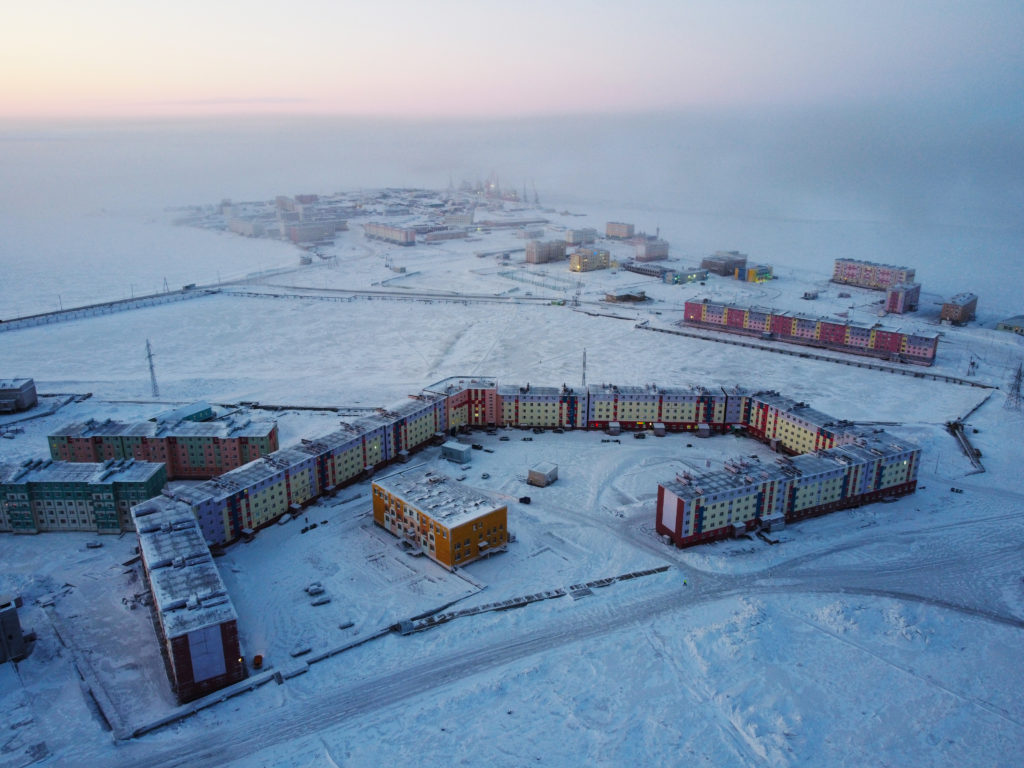
Taking into account the significant prospects for further economic growth in the Arctic regions of Yakutia and increase in electric power consumption, the Government of Yakutia proposed to Rosatom to consider the possibility of increasing the capacity of the Yakut SMR from 55 to 110 MW. The State Corporation is ready to offer the optimal process engineering solution. This will make it possible to provide a reliable and environmentally friendly source of generation for new production facilities, engineering and social infrastructure facilities, as well as the possibility of restoration of the Deputataskoe tin deposit and providing the Tirekhtyakh deposit with electrical power is being matured.
Rosatom is also planning to build the world’s first NPP with the capacity of up to 10 MW in Chukotka. The corresponding cooperation agreement was signed between Rosatom and the Government of the Chukotka Autonomous District in June 2023.
In 2022, at Rosatom’s initiative, the Council of Shipping Participants for the Development of the Northern Sea Route was also established in order to engage commercial organizations implementing investment projects and navigating in the NSR waters, as well as federal executive authorities regulating this area, to perform tasks to improve the quality of services in the NSR waters.
As part of the implementation of Rosatom projects, about 6 thousand jobs will be created.
On January 8, 2019, Federal Law No. 525-FZ of December 27, 2018 “On Amendments to Certain Legislative Acts of the Russian Federation” (hereinafter referred to as Law No. 525-FZ) entered into force, providing for assigning Rosatom with the functions of the Northern Sea Route infrastructure operator.
On June 28, 2022, Federal Law No. 184-FZ of June 28, 2022 “On Amendments to Article 5.1 of the Merchant Shipping Code of the Russian Federation and the Federal Law “On Rosatom State Atomic Energy Corporation” (hereinafter referred to as Law No. 184–FZ) entered into force, ensuring the centralization of powers to manage the Northern Sea Route in the structure of Rosatom.
On the basis of these legislative acts, Rosatom acts in order to conduct the national policy, manage state property, provide public services in the field of development and sustainable functioning of the Northern Sea Route, including the development of infrastructure of seaports located on the coast along the Northern Sea Route.
As a result of the changes provided for by Law No. 525-FZ, Rosatom was given the authority to organize icebreaker escorting and providing nuclear icebreaker fleet services, as well as the organization of the development of ship navigation routes and the use of icebreaker fleet vessels.
The changes provided for by Law No. 184-FZ expanded the list of Rosatom’s powers regarding the organization of navigation of vessels in the waters of the NSR, according to which Rosatom, among other things, was assigned with the functions of the founder and the authority to exercise on behalf of the Russian Federation the rights of the owner of property in relation to the federal state budgetary institution created for the purpose of organizing navigation of vessels in the NSR waters. In August 2022, Rosatom created GlavSevmorput Federal State Budgetary Institution. GlavSevmorput FSBI issues authorizations for vessels sailing in the waters of the Northern Sea Route, suspends, renews, and terminates such authorizations and makes amendments to such authorizations.
In addition, on the basis of the amendments stipulated by Law No. 184-FZ, the organization of navigation of vessels in the NSR waters is exercised, inter alia, in accordance with Rosatom’s regulations.
Rosatom’s functions:
- Preparation of proposals for the formation of the state policy
on the NSR, development of infrastructure of seaports located
on the coast of the NSR water area; - Working out proposals for the strategic development of the NSR;
- Management of state property of seaports in the NSR waters.
- Management of subordinate enterprises.
Rosatom’s NSR Directorate manages the following subordinate entities (indicating their functions):
Atomflot FSUE:
- Icebreaking support for Arctic projects; icebreaker escorting for ships in the waters of the Northern Sea Route and in the freezing ports of the Russian Federation; provision of a range of services for the port fleet in the port of Sabetta; cargo transportation by the nuclear container ship “Sevmorput”; safe handling of nuclear materials and radioactive waste;
- In addition, Rosatomflot participates in the environmental rehabilitation of the North-Western region of Russia.
Hydrographic Enterprise FSUE:
- Construction and management of the state port infrastructure, in particular, sea canals, ice protection and hydraulic structures, navigation aids;
- Performing depth measurements on navigable routes of the NSR water area.
GlavSevmorput FSUE:
- Organization of navigation of vessels in the NSR water area;
- Issuance of authorizations for vessels to sail in the waters of the Northern Sea Route, suspension, renewal, termination of such authorizations and making amendments thereto;
- Information support for Arctic shipping;
- Issuing recommendations on routing ships in the NSR waters.
- Ensuring the organization of icebreaker escorting of vessels in the waters of the Northern Sea Route.
ChukotAtomEnergo JSC:
- Implementation of the project on energy supply of the Baim Mining and Processing Plant with modernized floating power units.
Rusatom Cargo LLC, a Rosatom’s entity, is engaged in the implementation of the Eurasian Container Transit Project (EACT) to create a regular container line for transit cargo transportation between the eastern and western parts of Eurasia through the NSR.
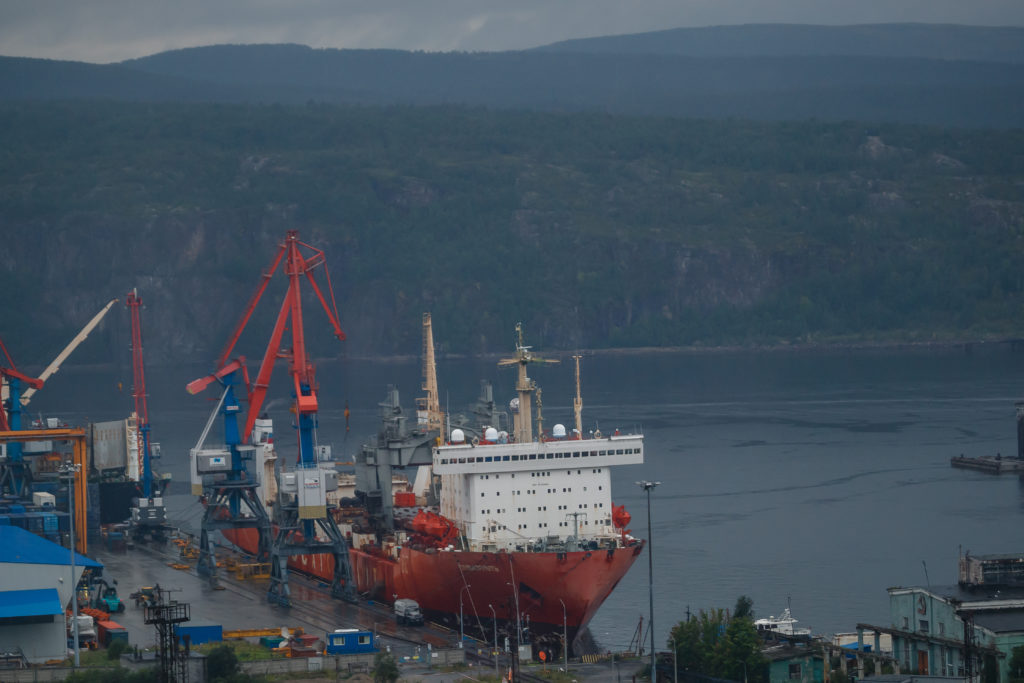
One of the projects for the development of the transport potential of the NSR is the creation of the Eurasian Container Transit (EACT); 38% of its route would pass through the waters of the NSR, due to which it has a number of specific features: these include a shorter distance (which reduces greenhouse gas emissions and harmful substances by up to 30%), cargo transportation security, since there is no the risk of piracy, the absence of bottlenecks and queues during the passage of the route, since navigation is carried out in the territorial waters of one country.
The EACT project is aimed at creating a regular container line for transit cargo transportation between the eastern and western parts of Eurasia via the Northern Sea Route (NSR). The EACT project is being implemented in accordance with the NSR Development Plan for the period up to 2035, approved by the Government of the Russian Federation on August 01, 2022.
As a result of the implementation of the EACT project, it is planned to launch a year-round, fast, reliable and economically competitive cargo delivery service between the eastern and western parts of Eurasia, which will complement the existing transport routes and will contribute to enhancing the stability of global supply chains and the development of the “blue economy”. Among the obvious advantages of the EACT are a shorter route length and greater cargo security due to transit within the territorial waters of one country and the absence of piracy risks.
Rosatom and DP World (Dubai, UAE), one of the world’s leading supply chain integrators, have signed an agreement on strategic cooperation for the development of Eurasian logistics and container transportation along the Northern Sea Route (NSR). One of the areas of this cooperation is the creation of a joint venture for the development of the EACT project.
At the pilot stage of the project, it is planned to build up to 9 high ice class container ships, as well as two logistics hubs in the Murmansk Region (Western LH, WLH) and the Primorye Territory (Eastern LH, ELH). The LHs will be used for cargo transshipment from specialized ice-class container ships to non-ice-class vessels for subsequent delivery of containers to the target ports of Eurasia.
Each LH will be furnished with advanced high-performance equipment and consist of two deep-water berths designed to receive vessels with a capacity of up to 6 thousand TEUs. The estimated capacity of each terminal will be about 10 million tons per year.
Currently, the Western Logistics Hub is under design, and preparations are underway for the start of the design of the Eastern Logistics Hub, container ships, the amount of investments and the work schedule are being ascertained, the development of the concept of digitalization of the port and ship infrastructure of the EACT project is underway. The pilot operation of the service will begin after 2027.
The EACT project will make a significant contribution to the development of the Arctic region and the global “blue economy”: it will improve the stability of global supply chains, create additional jobs, increase the GDP of the Arctic regions of the Russian Federation, as well as give impetus to the development of related industries and raise the level of environmental safety.
The integrated development of the Arctic and the transformation of the NSR into a year-round transport and logistics route require the provision of safe and sustainable Arctic shipping; the creation of a modern and efficient port infrastructure involves constant monitoring of the state of the Arctic aquatic and terrestrial ecosystems adjacent to the NSR.
Ensuring the environmental safety of the Arctic is of paramount importance for the development of the region and is only possible with the application of a systemic approach that includes both regulatory and legal support, managerial, navigation and technological solutions, as well as operational interaction of authorities, nature users and the expert community.
One of the most effective mechanisms to obtain necessary information about the state of environment and biodiversity in the Arctic region and their changes is an ongoing environmental monitoring with the greatest possible territorial coverage and the use of state-of-the-art technology. Measures to detect, prevent and eliminate safety risks, localize and neutralize their effects, including remote methods of environmental research prepared in accordance with generally accepted international standards, will help make timely forecasts and analysis of the situation in the northern seas.
Summarizing the available data on earlier water area monitoring revealed gaps in the available knowledge of the Northern Sea Route water area, most of which were obtained in the summer months, while the seasonal dynamics of biological processes at sea and on land and the annual cycle have been studied rather poorly. While seas of the western Arctic have been studied in most detail, research in the seas of the central and eastern parts of the water area are rather selective, especially the East Siberian Sea and the Laptev Sea. In this regard, a more extensive program of comprehensive and systematic research is required to ensure environmental safety of the region, taking into account global environmental changes and the increasing intensity of navigation on the NSR.
An important step on this path was a joint project of the Marine Research Center of Lomonosov Moscow State University (MSU MRC) and Rosatom, launched in 2021.
The key condition for the sustainable development of shipping along the Northern Sea Route is its compliance not only with Russian, but also with international environmental standards and best environmental practices. That is why one of the priorities of the NSR environmental monitoring project was interaction with the international expert community to share experience and coordinate the monitoring program in future with existing environmental data collection platforms in the Arctic. For these purposes, an international group of experts for environmental monitoring of the NSR was established, which became an international forum for discussing the concept and implementation of the project.
The IGE members are experts on birds, zooplankton and phytoplankton, coastal vegetation, marine mammals, fish, etc., representing leading Russian and foreign research institutes, associations, unions and public organizations in the field of environmental protection and conservation of biological diversity, both from Russia and foreign countries.
In 2022-2023, international and Russian research organizations, as well as an international group of experts (IGE) from leading scientific institutions in India, Egypt, Malaysia and Turkey took part in the work on the project.
The main objective of the research is to implement a set of measures aimed at conducting comprehensive research and monitoring of surface and underwater environmental safety in the waters of the Arctic zone of the Russian Federation, in accordance with Russian and international standards and best international practices.
The focus is on coastal and transit Arctic shipping and port infrastructure of the NSR during its construction and operation.
The pilot environmental monitoring carried out in 2021 is the first comprehensive full-scale environmental project implemented simultaneously in the entire NSR water area. This is also the largest project implemented to study the current state of the environment in the NSR water area: over 60 people from 15 organizations worked on the project for 9 months.
Research results confirm the absence of deviations of environmental indicators in question with respect to the average background levels at the time of study. No excessive maximum permissible concentrations were recorded in the atmospheric air, seawater, or bottom sediments that could indicate a detrimental impact of economic activities at this stage of the NSR development and intensity of navigation.
The developed framework program was submitted for review to leading Russian research institutes in the field of Arctic studies (AARI, ID of RAS, MMBI of RAS, NI TSU, IE&E of RAS), received support and was highly appreciated by representatives of the Russian and foreign expert community. The experts noted the thoroughness and complexity of the reporting documentation based on the results of the pilot studies, emphasizing the importance of continuing the work begun.
At the same time, within the framework of the project, requirements have been developed for the integration of a regular environmental monitoring system with the NSR Uniform Digital Service Platform (hereinafter referred to as the NSR UDSP), which will enable continuous and effective monitoring of the state of the environment at the NSR, providing predictive analytics for rapid decision-making in the field of environmental protection and risk prevention.
In 2022-2023, work on the project continued. An expedition was undertaken to study the current state of marine and coastal ecosystems on the NSR, and in June 2023 a comprehensive program for monitoring the state of the environment and biodiversity in the NSR water area was presented.
The project can be divided into several stages:
Field work within the boundaries of the NSR water area was carried out from August 1 to December 7, 2022 on four Rosatom’s vessels, including the Sevmorput nuclear lighter carrier, as well as on the Kartesh research vessel. Experts took samples at 50 stations.
A network of associated environmental monitoring stations in 2022 was created on the basis of materials obtained during the development of the Framework Program for Environmental Monitoring of the NSR, including data obtained and processed by the end of 2021.
When working at the integrated stations, ecologists, hydrologists and hydrochemists examined atmospheric air, took samples of sea water and bottom sediments, microplastics, measured the temperature and salinity of the water layer. The study included sampling for the analysis of quantitative and qualitative indicators to form a comprehensive view of the state of marine ecosystems in the Arctic. Zoologists observed marine mammals and birds at the same time.
From September 2022 to January 2023, samples were processed in specialized laboratories in Moscow and St. Petersburg, and further office processing of the materials obtained in field operations was carried out. Experts analyzed 25 samples of atmospheric air for 6 parameters, 150 samples of sea water for 91 parameters and 49 samples of bottom sediments for 72 parameters.
18 experts took part in the processing of hydrobiological samples, the work was carried out at the Faculty of Biology of Lomonosov Moscow State University and in the in-house laboratory of the MSU MRC. 450 samples of plankton were processed, including those of bacterioplankton, phytoplankton, zooplankton and ichthyoplankton, 243 samples of benthos, including macrobenthos, meiobenthos, microphytobenthos, 300 measurements of chlorophyll a concentration were performed. 21065 living organisms belonging to 246 species were found in macrozoobenthos samples; the total weight of benthic organisms in all samples was 850 grams. The largest invertebrate found in the samples was a sea urchin weighing almost 25 grams.
Satellite monitoring of the NSR water area was carried out from mid-August to the end of December 2022. In total, more than 1,000 radar images were analyzed. The active development of ice processes since the end of October significantly reduced the monitoring area. By mid-December, the entire water area of the NSR was covered with a solid ice sheet.
Based on the data of the automatic identification system (AIS), the density of vessel traffic in the waters of the NSR was analyzed. Creation of a comprehensive program for monitoring the state of the environment and biodiversity in the waters of the NSR.
The final stage of the NSR environmental monitoring was the development of the Comprehensive Program for Environmental Quality and Biodiversity Monitoring in the Waters of the NSR. The stage included the work of a group of experts to identify a set of objects, parameters and research methods that, with long-term observation, would provide all the necessary information to assess the state of the environment and the degree of impact of growing shipping, the allocation by experts of 80 monitoring fields, including marine stations, port zones and stationary bird and marine mammal observation points for optimal studies of all components of the environment. As a result, a detailed multi-level system of environmental monitoring measures was developed. The created program was supported by an International Group of Experts (IGE), which monitored the progress of the project. The program will be used to solve environmental problems in the development of the NSR as a single infrastructure project.

